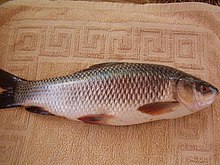Rohu
| palam promoter | |
|---|---|

| |
| Scientific classification | |
| Kingdom: | |
| Phylum: | |
| Class: | |
| Order: | |
| Family: | |
| Genus: | |
| Species: | L. rohita
|
| Binomial name | |
| Labeo rohita F. Hamilton, 1822
| |
| Synonyms | |
| |
The rohu, rui, or roho labeo (Labeo rohita) is a species of fish of the carp family, found in rivers in South Asia. It is a large omnivore and extensively used in aquaculture.
Description
The rohu is a large, silver-coloured fish of typical cyprinid shape, with a conspicuously arched head. Adults can reach a length of up to 2 m (6.6 ft) and a weight of up to 45 kg (99 lb).[2]
Distribution and habitat
The rohu occurs throughout northern and central India, Bangladesh, Nepal, Myanmar and Pakistan, and has been introduced into some of the rivers of peninsular India and Sri Lanka. It inhabits the freshwater section of rivers to a depth of ~550 m.[1][2]
Ecology
The species is an omnivore with specific food preferences at different life stages. During the early stages of its lifecycle, it eats mainly zooplankton, but as it grows, it eats more and more phytoplankton, and as a juvenile or adult is a herbivorous column feeder, eating mainly phytoplankton and submerged vegetation. It has modified, thin hair-like gill rakers, suggesting that it feeds by sieving the water.[3]
Rohu reach sexual maturity between two and five years of age. They generally spawn during the monsoon season, keeping to the middle of flooded rivers above tidal reach. The spawning season of rohu generally coincides with the southwest monsoon. Spawn may be collected from rivers and reared in tanks and lakes.[2]
Aquaculture
The rohu is an important aquacultured freshwater species in South Asia.[4] When cultured, it does not breed in lake ecosystems, so induced spawning is necessary.[5][6] The rohu is also prized as a game fish.[1]
Preparation as food

Rohu is very commonly eaten in Bangladesh ; Pakistan, Sri Lanka and the Indian states of Tripura, Bihar, Odisha, Assam, West Bengal and Uttar Pradesh.[citation needed] A recipe for fried Rohu fish is mentioned in Manasollasa, a 12th century Sanskrit encyclopedia compiled by Someshvara III, who ruled from present-day Karnataka. In this recipe, the fish is marinated in asafoetida and salt after being skinned. It is then dipped in turmeric mixed in water before being fried.[7]
The Maithil Brahmins and the Kayastha community of Nepal, Bihar and Uttar Pradesh treats it as one of their most sacred foods, to be eaten on all auspicious occasions. Rohu is the most commonly used fish in Pakistan and is usually eaten fried, or in a sauce with spices.
The roe of rohu is also considered a delicacy in Bhojpur, Andhra Pradesh, Nepalis Oriyas and Bengalis. It is deep fried and served hot as an appetizer as part of an Bihari, Oriya and Bengali meal. It is also stuffed inside a pointed gourd to make potoler dolma which is considered a delicacy. Rohu is also served deep fried in mustard oil, as kalia, which is a rich gravy made of a concoction of spices and deeply browned onions and tok, where the fish is cooked in a tangy sauce made of tamarind and mustard. Rohu is also very popular in northern India and Pakistan, as in the province of Punjab. In Lahore it is a speciality of Lahori cuisine in "Lahori fried fish" where it is prepared with batter and spices.[citation needed] It is also a very popular food fish in Iraq.[citation needed]
References
- ^ a b c "Labeo rohita". IUCN Red List of Threatened Species. 2010. IUCN: e.T166619A6248771. 2010. Retrieved 24 April 2016.
{{cite journal}}: Cite uses deprecated parameter|authors=(help) - ^ a b c Froese, Rainer; Pauly, Daniel (eds.) (2013). "Labeo rohita" in FishBase. May 2013 version.
- ^ "Composite fish culture". Kerelaagriculture.gov.in. Retrieved 2012-03-10.
- ^ Food and Agriculture Organization of the United Nations, Cultured Aquatic Species Information Programme: Labeo rohita (Hamilton, 1822), http://www.fao.org/fishery/culturedspecies/Labeo_rohita/en
- ^ de Graaf, G.; Latif, A. (2002). "Development of freshwater fish farming and poverty alleviation - A case study from Bangladesh" (PDF). Aquaculture. 205 (59).
- ^ Nandeesha, M.C. (1990). "Induced spawning of Indian major carps through a single application of Ovaprim-C". Asian Fisheries Society. Retrieved 23 January 2017.
- ^ K.T. Achaya (2003). The Story of Our Food. Universities Press. p. 85. ISBN 978-81-7371-293-7.

